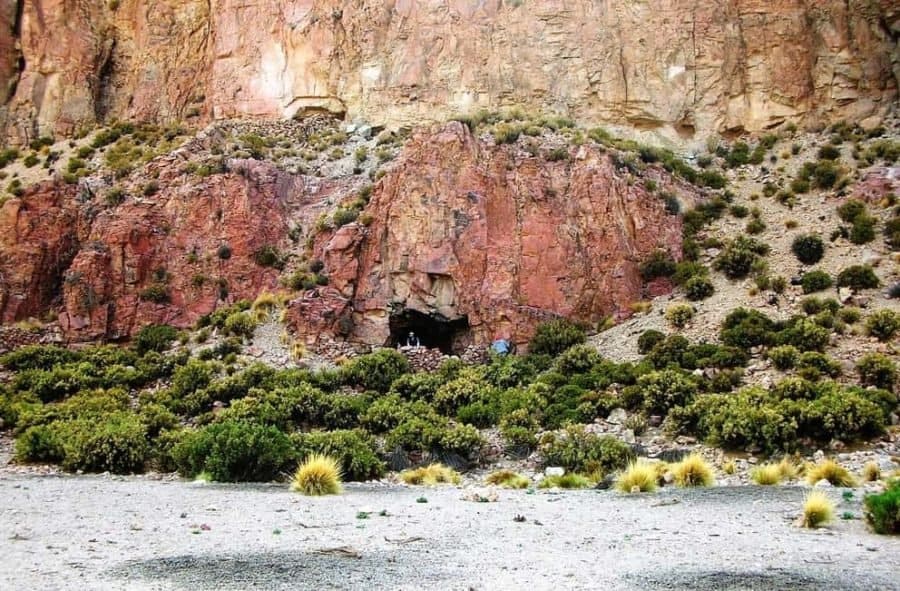One thousand years ago, Native Americans in South America used multiple psychotropic plants — possibly simultaneously — to induce hallucinations and altered consciousness, according to an international team of anthropologists.
“We already knew that psychotropics were important in the spiritual and religious activities of the societies of the south-central Andes, but we did not know that these people were using so many different compounds and possibly combining them together,” said Jose Capriles, assistant professor of anthropology, Penn State. “This is the largest number of psychoactive substances ever found in a single archaeological assemblage from South America.”
The researchers were searching for ancient occupations in the dry rock shelters of the dry Sora River valley in southwestern Bolivia when they found a ritual bundle as part of a human burial. The bundle — composed of a leather bag — contained, among other things, two snuffing tablets used to pulverize psychotropic plants into snuff; a snuffing tube for smoking hallucinogenic plants; and a pouch constructed of three fox snouts.
The team used accelerator mass spectrometry radiocarbon dating to determine the age of the outer leather bag and found that it was about 1,000 years old.
“This period in this location is associated with the disintegration of the Tiwanaku state and the emergence of regional polities,” said Capriles.
In addition, the team obtained a tiny scraping from the interior of the fox-snout pouch and analyzed the material using liquid chromatography with tandem mass spectrometry.
“This method is highly sensitive and very effective for detecting the presence of minute amounts of specific compounds from very small samples,” said Melanie Miller, postdoctoral fellow at the University of Otago, New Zealand, and research affiliate at the University of California, Berkeley, who was responsible for analysing the samples.
Through the procedure, the researchers identified the presence of multiple psychoactive compounds — cocaine, benzoylecgonine (the primary metabolite of cocaine), harmine, bufotenin, dimethyltryptamine (DMT) and possibly psilocin (a compound found in some mushrooms) — from at least three different plant species (likely Erythroxylum coca, a species of Anadenanthera and Banistesteriopsis caani). The results appear today (May 6) in Proceedings of the National Academy of Sciences.
According to Capriles, the fox-snout pouch likely belonged to a shaman.
“Shamans were ritual specialists who had knowledge of plants and how to use them as mechanisms to engage with supernatural beings, including venerated ancestors who were thought to exist in other realms,” said Capriles. “It is possible that the shaman who owned this pouch consumed multiple different plants simultaneously to produce different effects or extend his or her hallucinations.”
Miller noted the co-occurrence of harmine and DMT, which are the primary ingredients of modern ayahuasca preparations — a beverage that is reported to induce hallucinations and altered consciousness.
“This chemical evidence suggests the possibility of an early form of ayahuasca-type preparation combining plants containing harmine and tryptamines such as DMT and/or bufotenine,” she said.
Capriles noted that some scholars believe that ayahuasca has relatively recent origins, while others argue that it may have been used for centuries, or even millennia,” said Capriles.
“Given the presence of harmine and DMT together in the pouch we found, it is likely that this shaman ingested these simultaneously to achieve a hallucinogenic state, either through a beverage, such as ayahuasca, or through a composite snuff that contained these plants in a single mixture,” he said. “This finding suggests that ayahuasca may have been used up to 1,000 years ago.”
Not only does the presence of numerous compounds suggest simultaneous use of multiple psychotropic plants and earlier use of ayahuasca, in particular, but it also indicates intricate botanical knowledge by the owner of the pouch and an effort to acquire hallucinogenic plants, as the plants came from different regions of mostly tropical South America.
“The presence of these compounds indicates the owner of this kit had access to at least three plants with psychoactive compounds, but potentially even four or five,” said Miller. “None of the psychoactive compounds we found come from plants that grow in this area of the Andes, indicating either the presence of elaborate exchange networks or the movement of this individual across diverse environments to procure these special plants. This discovery reminds us that people in the past had extensive knowledge of these powerful plants and their potential uses, and they sought them out for their medicinal and psychoactive properties.”
Other authors on the paper include Juan Albarracin-Jordan, research associate, Universidad Mayor de San Andrés, Bolivia; and Christine Moore, chief toxicologist at Immunalysis Corporation.
The National Geographic Society Grant and the Bartolome de Las Casas Foundation supported this research.




